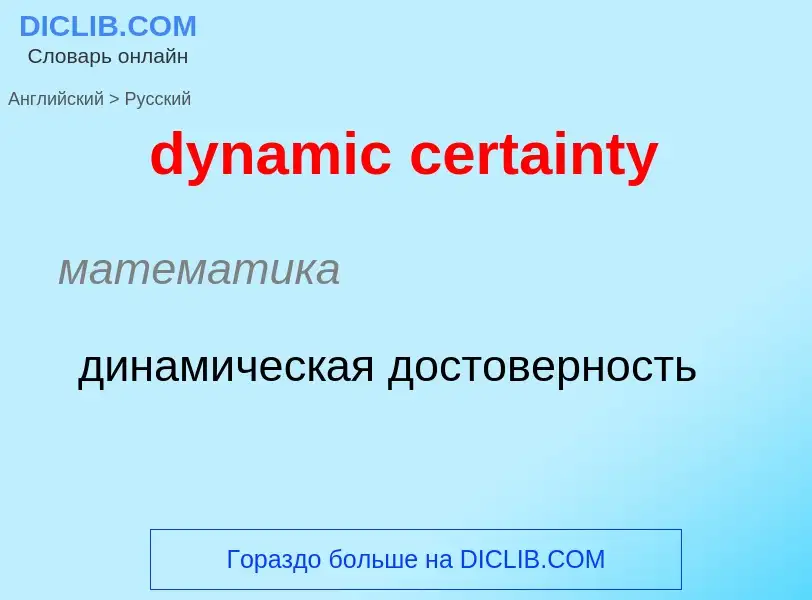Vertaling en analyse van woorden door kunstmatige intelligentie ChatGPT
Op deze pagina kunt u een gedetailleerde analyse krijgen van een woord of zin, geproduceerd met behulp van de beste kunstmatige intelligentietechnologie tot nu toe:
- hoe het woord wordt gebruikt
- gebruiksfrequentie
- het wordt vaker gebruikt in mondelinge of schriftelijke toespraken
- opties voor woordvertaling
- Gebruiksvoorbeelden (meerdere zinnen met vertaling)
- etymologie
dynamic certainty - vertaling naar russisch
математика
динамическая достоверность
['sə:tnli]
наречие
общая лексика
конечно
непременно
несомненно
безусловно
в ответах на вопросы
конечно, непременно
математика
объективная достоверность
Definitie
Wikipedia
 by George Richmond and John Henry Robinson.jpg?width=120)
The three certainties refer to a rule within English trusts law on the creation of express trusts that, to be valid, the trust instrument must show certainty of intention, subject matter and object. "Certainty of intention" means that it must be clear that the donor or testator wishes to create a trust; this is not dependent on any particular language used, and a trust can be created without the word "trust" being used, or even the donor knowing he is creating a trust. Since the 1950s, the courts have been more willing to conclude that there was intention to create a trust, rather than hold that the trust is void. "Certainty of subject matter" means that it must be clear what property is part of the trust. Historically the property must have been segregated from non-trust property; more recently, the courts have drawn a line between tangible and intangible assets, holding that with intangible assets there is not always a need for segregation. "Certainty of objects" means that it must be clear who the beneficiaries, or objects, are. The test for determining this differs depending on the type of trust; it can be that all beneficiaries must be individually identified, or that the trustees must be able to say with certainty, if a claimant comes before them, whether he is or is not a beneficiary.
There are four categories of uncertainty that can affect the validity of a trust: conceptual uncertainty, evidential uncertainty, ascertainability and administrative unworkability. "Conceptual uncertainty" is where the language is unclear, something which leads to the trust being declared invalid. "Evidential uncertainty" is where a question of fact, such as whether a claimant is a beneficiary, cannot be answered; this does not always lead to invalidity. "Ascertainability" is where a beneficiary cannot be found, while "administrative unworkability" is where the nature of the trust is such that it cannot realistically be carried out. Trustees and the courts have developed various ways of getting around uncertainties, including the appointment of experts to work out evidential uncertainty, and giving trustees the power to decide who is or is not a beneficiary.
The rule came out of the case of Knight v Knight. The testator, after giving away his personal and real property, added to the end of his will that "I trust to the justice of my successors, in continuing the estates in the male succession, according to the will of the founder of the family". Langdale MR, hearing the case, held that this was not specific enough to create a valid trust; furthermore, to be held as valid, trust instruments would have to have:
- Certainty of intention: it must be clear that the testator intends to create a trust
- Certainty of subject matter: it must be clear what property is part of the trust and property, including sum of money, cannot be separated.
- Certainty of objects: it must be clear who the beneficiaries (objects) are.
Note: The 'Three certainties' rule is not novel to Knight v Knight. It was first stated in Wright v Atkyns, by Earl Eldon LC.

![Lord Langdale]], who first conceptualised the three certainties in ''[[Knight v Knight]]'' Lord Langdale]], who first conceptualised the three certainties in ''[[Knight v Knight]]''](https://commons.wikimedia.org/wiki/Special:FilePath/Henry Bickersteth, Baron Langdale (19th century) by George Richmond and John Henry Robinson.jpg?width=200)
